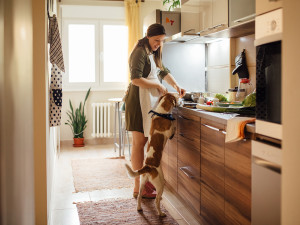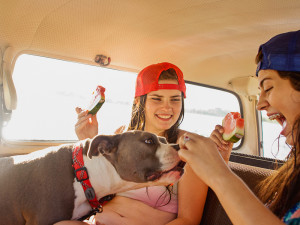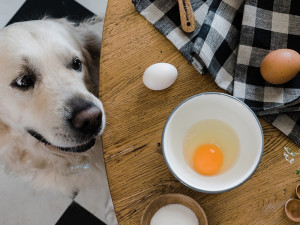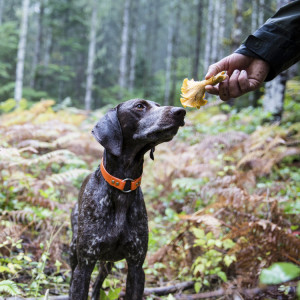Can Dogs Eat Rice? And More Importantly, Should They?
Yes, actually. Just follow these guidelines.
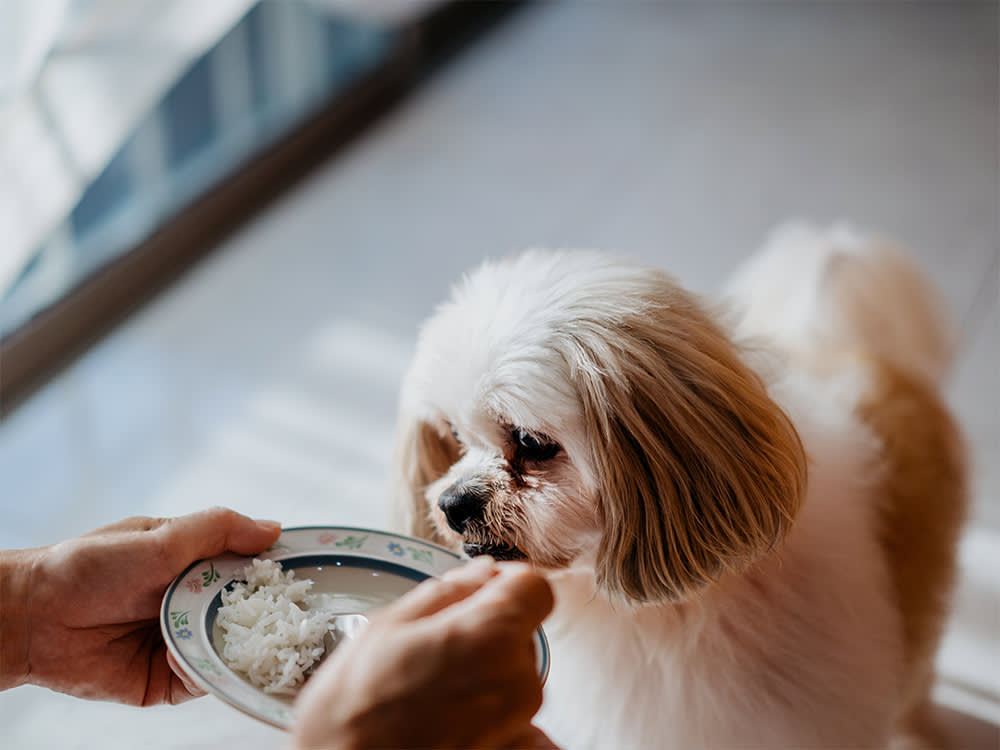
share article
There’s truly nothing better than a simple bowl of rice — especially when you only have odds and ends left in the pantry and fridge. When you make a kitchen-sink meal of random ingredients over a warm bed of rice, you suddenly feel like a gourmet chef. True excellence. And while you make this truly genius meal with limited ingredients, your pup could be standing by, asking for a simple snack of plain rice. But can they indulge?
Can Dogs Eat Rice?
As an educated pet parent, you are likely aware of many foods that can make your pup sickopens in a new tab, despite being perfectly safe for you to eat. You may be wondering if rice is a safe choice for dogs. The good news is that rice is perfectly safe for dogs and may even be recommended in certain situations. Learn all about rice and how it may benefit your pup.
What is rice?
Riceopens in a new tab is a cereal-style grain that grows from a grass species called Oryza sativa. Harvested rice kernels have an outermost hull as well as fibrous layers known as bran layers. When rice is prepped for us to eat it, the outer husk is removed. If this is the only processing done to the kernels, the final product is brown rice. When the kernels are milled after this point, the bran layers are also removed, and the final product is white rice.
There are many different varieties of rice grown around the world. Some of the most common kinds of rice include long-grain rice, such as jasmine rice and basmati rice, medium-grain rice such as Valencia, and short-grain rice, such as sushi rice. They differ slightly in their appearances, flavors, and nutrient profiles.
Can rice be used to treat certain health conditions in dogs?
Rice can be part of a healthy, balanced diet for dogs and is found in many commercial dog foods. It may be recommended as a carbohydrate source for dogs with a wheat allergy, as well as in the short-term treatment of certain kinds of gastrointestinal upset, like diarrheaopens in a new tab.
When the intestines are inflamed due to an infection, garbage-eating (yes, quite literally), pancreatitis, or other conditions that irritate the lining of the intestines, you should provide your pup with an easily digestible diet. This means temporarily feeding a diet that is low in fiber, low in fat, and has simple carbohydrates that are easy to break down. Because the intestines are so inflamed, they need a break and giving them ingredients that are easy to digest means less work and more time to focus on healing. Interestingly, there are other components in rice that may be especially helpful in the treatment of diarrheaopens in a new tab, including pectin, which helps to absorb excess water in the intestines and firm up the poop. It can also improve the absorption of water and electrolytes, limiting dehydration and helping to put an end to their diarrhea more quickly.
What are the benefits of rice for dogs?
Rice is a carbohydrate that may also provide other important nutrients depending on which variety you feed your pup. It can be an excellent ingredient within a complete and balanced diet for your dog when used appropriately.
Carbohydrates
Rice is primarily a source of carbohydrates for dogs. Unlike certain nutrients, carbohydrates are not required for dogs to have a healthy diet, however they do provide many important benefits. Carbohydrates are broken down into sugars and starches, important sources of energy.
Fiber
If you are feeding your pup brown rice, it provides an excellent source of fiber. Fiber is a food source for the good bacteria within the gut, known as the microbiome. It also bulks up the stool, prevents constipationopens in a new tab, and can allow your pup to feel full more quickly. On the other hand, white rice is very low in fiber. This can also be beneficial in certain instances, such as for those pups with diarrhea that need to eat an easily digestible diet.
Low Fat
Rice is low in fat while also providing lots of energy. This may be important in certain health conditions, such as pancreatitisopens in a new tab, when your pup needs to avoid high fat foods and eat a very low fat diet. It is important to make sure that dogs eating a low fat diet can still get the energy they need, especially if they are very active.
Can rice be a part of a long-term diet for dogs?
Rice can be an excellent ingredient in a long-term diet and is often found in commercial dog foods intended for everyday use and long-term use. Be sure to check that the diet you are feeding your dog includes a nutrition adequacy statement that the diet is complete and balanced to meet Animal Feed Control Officials (AFFCO) standardsopens in a new tab for your pup’s stage of life.
Homemade bland diets, such as those containing white rice and lean protein, are used short-term for dogs with diarrhea or other gastrointestinal upset. They are not safe to be used as a long-term diet since they lack many critical vitamins and nutrients and are not balanced to have the right ratio of carbohydrates, protein, and fats. If your veterinarian recommends a bland diet, she will usually give you specific instructions as far as how long to feed it and when to transition back to a commercial dog food diet. Depending on your pup’s condition and whether it is expected to be chronic, your vet may recommend a safe, long-term diet change as well based on your dog’s needs.
Varieties of Rice
There are many varieties of rice out there, and the good news is that they are all safe for your pup in moderation.
Brown Rice
Brown rice is the least processed form of rice. The outer hull is removed from the kernel but it is not milled. This means it still contains the bran layers of the kernel, which have most of the fiber as well as other valuable nutrients. In recent years there have been reports that rice accumulates high concentrations of a toxin called arsenicopens in a new tab compared to other grains and that brown rice has higher concentrations of arsenic because the toxin is absorbed into the bran layers. There have been no studies in dogs to verify if this is a concern for them, and there have been no reported cases of arsenic toxicity in dogs from rice consumption so brown rice is considered safe in moderation.
White Rice
White rice is the final product formed when brown rice is milled to remove the bran layers. The final product is low in fiber and is very easy to digest.
Basmati Rice
Basmati rice is a long-grain form of white rice. It originated in India, Pakistan and Nepal and tends to have a unique smell and slightly nutty taste. It is the same species of rice, Oryza sativa, but a different variation and it is safe for dogs as well.
How much rice should I feed my dog?
Dogs do not have a specific amount of carbohydrates they need to eat in order to meet their nutritional demands, so there is no exact quantity that you should feed your pup. In a commercial diet, the amount of total carbohydrates is not usually listed on the label and it can be difficult to determine. Usually, carbohydrates are included in the Nitrogen Free Extractopens in a new tab count, which is basically everything that is left over after accounting for fiber, protein, fat, minerals, and moisture.
If you feed your pup a commercial pet food, you may not know exactly how much rice or other carbohydrates are in the food. As long as it meets the overall nutritional requirements to be complete and balanced, it doesn’t usually matter for most dogs. If your pup has a specific health condition that requires a low carbohydrate diet, speak with your veterinarian as there may be a special diet she recommends.
If you are trying to get your dog’s poop to firm up after a bout of diarrhea, you are likely home-cooking a simple mixture of low-fat proteins, such as steamed chicken or low-fat cottage cheese, mixed with white rice. In that case, the general recommendation is to make a one-to-one ratio of equal parts protein and rice and avoid adding any oil, butter, salt or other seasonings.
Usually, a dog who needs a bland diet isn’t feeling great overall and may also have a decreased appetite and/or be vomitingopens in a new tab, so the total amount you are feeding is reduced, too. Start with small meals that are about one-fourth of the size of their normal portion. If your pup eats that and holds it down, you can offer small, frequent feedings every six hours or so for the first few days. As your pup improves and their appetite increases, you can stretch the size of the feedings gradually over the next few days and space them out more. Most veterinarians will only recommend a bland diet for a short time, usually a matter of days. Then you should gradually mix in your pup’s regular diet to transition them back to their normal feeding routine. If your pup is not improving within a few days or has a more unique health situation, be sure to follow your veterinarian’s feedings recommendations precisely.
Are there any risks associated with feeding rice to dogs?
There are very few risks to consider when feeding rice to dogs. It is a common ingredient in many dog foods because it is usually very well-tolerated and provides many important nutrients.
Allergic Reactions
Some dog parents may worry about allergies and allergic reactions, especially with the explosion of grain-free diets in recent years. The truth is that rice is not considered a common allergen for dogs. The most common allergens reported for dogs are beef, dairy, chicken, egg, wheat, soy, and corn. While there could be a dog that is allergic to rice out there, it would be very unusual. If you are experimenting with any new diet or new ingredients in your dog’s repertoire, and they don’t seem to tolerate it well, take a break and contact your vet. Signs of an allergy could include hives, swelling of the face, itchy skin, vomiting, diarrhea, or difficulty breathing.
Digestive Problems
Cooked rice is considered an easily digestible source of carbohydrates, so dogs do not usually have any problems with eating rice. You may be intrigued to learn that domestic dogs actually evolved to be better at digesting starchesopens in a new tab like rice and have more genes that encode these enzymes compared to wild wolves. And while there is a lot of marketing aimed at making you think your happily domesticated Poodle needs to eat a diet suitable for their wild wolf ancestors, that is not exactly true.
Food Bloat
While cooked rice is easily digestible, uncooked rice is not so kind to the digestive tract, and hopefully way less appetizing. While it seems hard to imagine a dog chowing down on uncooked crunchy rice kernels, it has been known to happen. Dogs that consume a large amount of uncooked rice could be at risk of food bloat. This is because uncooked rice is much harder to digest and tends to draw in water. It can form a sticky blob in the stomach and move through the digestive tract very slowly. Most of these cases will respond well to medical treatment including IV fluids and drugs to improve movement of the digestive tract, but, in extreme cases, surgical removal of the rice may be required.
Arsenic Toxicity
Rice accumulates high concentrations of a toxin called arsenicopens in a new tab compared to other grains. Brown rice tends to have higher concentrations of arsenic because the toxin is absorbed into the bran layers. There have been no studies in dogs to verify if this results in elevated arsenic levels in their body, and there have been no reported cases of arsenic toxicity in dogs from rice consumption. Brown rice is considered safe for dogs in moderation and arsenic toxicity from rice is not considered a concern for dogs at this time.
Rice is a healthy food for most dogs and may be part of a complete and balanced diet. Depending on your pup’s needs, brown rice may be an excellent ingredient in their diet; it not only provides carbohydrates but also contains lots of fiber and other important nutrients. For dogs that are experiencing diarrhea and other signs of gastrointestinal distress, white rice is an important part of a bland diet. It is easily digestible and also has components that promote the absorption of water and electrolytes.
FAQs
1) What are the benefits of rice for dogs?
Rice is a great source of carbohydrates for dogs and provides much needed energy for their daily activities. Brown rice is also a great source of fiber and other vital nutrients, while white rice is the most easily digestible and may be beneficial for pups with diarrhea.
2) Are there any risks associated with feeding rice to dogs?
There are minimal risks in feeding rice to dogs. The most important considerations are that it should be part of a complete and balanced diet in order to prevent nutritional deficits and uncooked rice should be kept out of reach.
3) How much rice should I feed my dog?
There is not a set amount of rice or other carbohydrate that is required for dogs to have proper nutrition but it is often included in commercial dogs foods. If you are feeding a short-term bland diet to a sick dog, be sure to consult your veterinarian on how much to feed. Usually, you’ll want to start with small feedings until you see how your pup tolerates it.
4) Can rice be a part of a long-term diet for dogs?
Yes, rice can be part of a long-term diet and it is often a common ingredient in commercial dog food. A long-term diet must be complete and balanced to meet all of a dog’s nutritional needs, so as long as the food contains a statement on the label that it meets AAFCO standards for a complete and balanced diet, it can be used long-term. Simple, homemade diets such as the bland diet of white rice and chicken are not safe to use long-term because they are missing many important nutrients.
5) Can rice be used to treat certain health conditions in dogs?
White rice is often used as part of a homemade bland diet in the short-term treatment of diarrhea or other gastrointestinal problems. This should be done in consultation with your veterinarian as the diet alone is not a cure and additional treatments will be necessary. Brown rice is high in fiber and may be a helpful ingredient for dogs that need to increase their fiber intake as part of a larger treatment plan.
Resources:

Dr. Amy Fox, DVM
Amy Fox, DVM is a small animal veterinarian in New York City. A lifelong animal lover, Dr. Fox studied biology in college and then worked as a veterinary nurse before pursuing veterinary school at Cornell University. She has worked in many different settings including shelter medicine, emergency medicine, general practice, and animal cruelty and forensics. She is especially interested in nutrition, preventative medicine and care for senior pets. Dr. Fox also enjoys writing about veterinary medicine and teaching. In her free time she loves to cook, garden, and go for long runs.
Related articles
![Teenagers Feeding a Dog Watermelon While Sitting In Car On a Sunny Day]() opens in a new tab
opens in a new tab9 Healthy Summer Snacks to Share With Your Dog
Your pup wants in on your crudité platter.
![brown dog begging for food at table]() opens in a new tab
opens in a new tabHuman Foods Toxic to Dogs — From A-Z
Even if they ain’t too proud to beg…
![Dog in the kitchen with girl making cookies from dough on the counter]() opens in a new tab
opens in a new tabRaw Dough and Dogs Don’t Mix
Active yeast puts dogs at risk for obstruction and alcohol poisoning.
![Golden retriever looks at some eggs on the counter]() opens in a new tab
opens in a new tabCan Dogs Eat Eggs?
Get that protein, bro.
![A dog sniffing a mushroom out of a hand.]() opens in a new tab
opens in a new tab6 Mushroom Superfoods that Won’t Turn Your Dog Into a Zombie
Nothing to fear here The Last of Us fans — ’shrooms are great immune-boosters.
![Puppy eating a bowl of blueberries]() opens in a new tab
opens in a new tab10 Superfoods to Share With Your Dog
From kale to quinoa, these nutrient-packed picks deserve a spot in your dog’s food bowl.

